冀教版八年级英语下册教案Unit 2 第2课时
- 格式:doc
- 大小:48.50 KB
- 文档页数:4
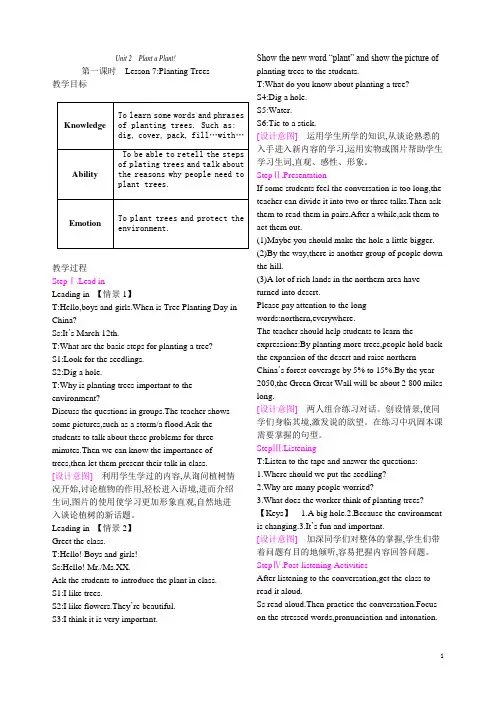
Unit 2Plant a Plant!第一课时Lesson 7:Planting Trees教学目标教学过程StepⅠ.Lead inLeading in 【情景1】T:Hello,boys and girls.When is Tree Planting Day in China?Ss:It’s March 12th.T:What are the basic steps for planting a tree?S1:Look for the seedlings.S2:Dig a hole.T:Why is planting trees important to the environment?Discuss the questions in groups.The teacher shows some pictures,such as a storm/a flood.Ask the students to talk about these problems for three minutes.Then we can know the importance of trees,then let them present their talk in class.[设计意图]利用学生学过的内容,从询问植树情况开始,讨论植物的作用,轻松进入语境,进而介绍生词,图片的使用使学习更加形象直观,自然地进入谈论植树的新话题。
Leading in 【情景2】Greet the class.T:Hello! Boys and girls!Ss:Hello! Mr./Ms.XX.Ask the students to introduce the plant in class.S1:I like trees.S2:I like flowers.They’re beautiful.S3:I think it is very important. Show the new word “plant” and show the picture of planting trees to the students.T:What do you know about planting a tree?S4:Dig a hole.S5:Water.S6:Tie to a stick.[设计意图]运用学生所学的知识,从谈论熟悉的入手进入新内容的学习,运用实物或图片帮助学生学习生词,直观、感性、形象。
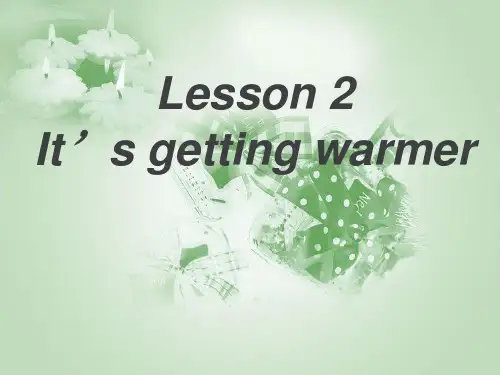
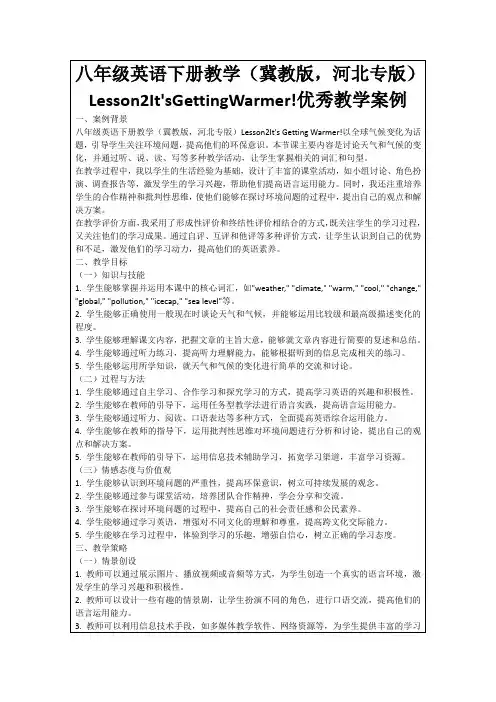
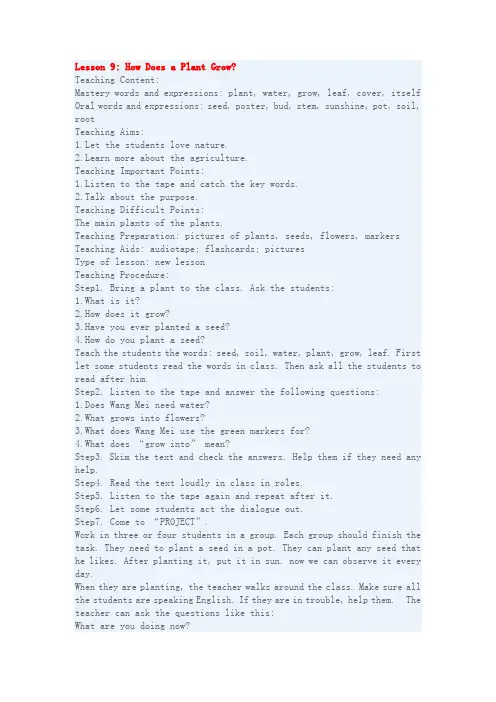
Lesson 9: How Does a Plant Grow?Teaching Content:Mastery words and expressions: plant, water, grow, leaf, cover, itself Oral words and expressions: seed, poster, bud, stem, sunshine, pot, soil, rootTeaching Aims:1.Let the students love nature.2.Learn more about the agriculture.Teaching Important Points:1.Listen to the tape and catch the key words.2.Talk about the purpose.Teaching Difficult Points:The main plants of the plants.Teaching Preparation: pictures of plants, seeds, flowers, markers Teaching Aids: audiotape; flashcards; picturesType of lesson: new lessonTeaching Procedure:Step1. Bring a plant to the class. Ask the students:1.What is it?2.How does it grow?3.Have you ever planted a seed?4.How do you plant a seed?Teach the students the words: seed, soil, water, plant, grow, leaf. First let some students read the words in class. Then ask all the students to read after him.Step2. Listen to the tape and answer the following questions:1.Does Wang Mei need water?2.What grows into flowers?3.What does Wang Mei use the green markers for?4.What does “grow into” mean?Step3. Skim the text and check the answers. Help them if they need any help.Step4. Read the text loudly in class in roles.Step5. Listen to the tape again and repeat after it.Step6. Let some students act the dialogue out.Step7. Come to “PROJECT”.Work in three or four students in a group. Each group should finish the task. They need to plant a seed in a pot. They can plant any seed that he likes. After planting it, put it in sun. now we can observe it every day.When they are planting, the teacher walks around the class. Make sure all the students are speaking English. If they are in trouble, help them. The teacher can ask the questions like this:What are you doing now?Have you watered your seeds?What do you cover with it?When will they sprout?Make sure that every group labels their pots with their names or group number (Example: Group 1). You may wish t have students also write the type of seed and the date on the label.Every group makes a poster with pictures and words. Describe what their plants will be like. What do they do? Instruct the students to label each part of the plant in English. Have them label which parts of the plant are above ground and which parts are below.Summary:Bring a real plant to the class. Point to the parts of the plant and ask some questions. Because this unit is about the plant, we must finish the project. Of course we can’t finish it in a class. We can do it after class and check the homework in the next class. Lesson 10: Plant PartsTeaching Content:Mastery words and expressions: feed, fed, from…to…Oral words and expressions: sunlight, billion, billions ofTeaching Aims:1.Learn to describe how a plant grows.2.Learn about plant parts and what they use for.Teaching Important Points:1.Plant parts and what they are used for.2.Describe it in English.Teaching Difficult Points:Describe plant parts and what they are used for in English.Teaching Preparation: pictures, a plantTeaching Aids: audiotape, flashcards, picturesType of lesson: new lessonTeaching Procedure:Step1. Bring a real plant to the class. Ask the following questions:1.How many parts do plants have?2.What do roots do?3.What is the stem for?4.What are leaves for?5.Why do plants have flowers?6.What parts do we eat?Let them answer the questions in English. If they have trouble, help them immediately.Step2. Listen to the tape and let the students complete the answers correctly.Step3. Read the text and check the answers.Step4. PracticeLet the students take out the pictures they bring to the class. Work with partner. Talk about the main parts of a plant and the main use of them. If they have difficulty, they can look at their book.Step5. Listen to the tape again and imitate after it until they can read it fluently and correctly.Step6. Let some students read the text in class. Find the mistakes and correct them.Step7. Homework1.Finish off the activity book.2.Go on the next reading in the student book.Summary:Review the text is very important. The students know what they will take to the class, what is useful to the study. Let them to observe the vegetables that we eat. What parts do we eat? What is it used for? Can they draw pictures of them?Lesson 11: Look after Your Plant!Teaching Content:Mastery words and expressions: look after, over, glass, be made of Oral words and expressions: sprout, desert, use…to do…Teaching Aims:1.Learn about what a plant needs if it wants to live well.2.What does a plant use sunlight, water do?Teaching Important Points:1. Describe the process that a plant grows.3.Know the main parts of a plant and what they use water and sunlight to do.Teaching Difficult Points:Use the Simple Present TenseTeaching Preparation: a plantTeaching Aids: audiotape, flashcards, plantsType of lesson: new lessonTeaching Procedure:Step1. Play a game.Put some things in a box. Then let a student come to the front and touch every thing. Describe what it is like and let the students guess what it is. Divide the class into two groups and have a match. Which team is better? Step2. Bring a plant to the class and let the students ask questions about plants by themselves.Pointing to the plant, they may begin like this:1.What is this?2.What is it used for?3.Why do plants need sunlight?4.Why do plants need water?5.Why do plants need glass?Step3. Listen to the tape and check the answers.Step4. Read the text aloud in class. Find the mistakes and correct them. Step5. Listen to the tape again and repeat after it until they can read it correctly and fluently.Step6. PracticeAsk the students if they have planted flowers. Let some students introduce the planting experience.Work in pairs. Introduce one plant that they love very much.Step7. Homework1.Finish off the activity book.2.Go on the next reading in the student book.Summary:Let the students take active part in the activities. The teacher creates all kinds of chances to stimulate the students’ interests. Use the experience that they have. Talk about what they have known.Lesson 12: Pretty Little PlantTeaching Content:Mastery words and expressions: pretty, hole, itsTeaching Aims:1.Talk about the relation between the human and the nature.2.Teach people to love the plants and animals and value our lives. Teaching Important Points:1.Learn about how a plant grows.2.Realize the importance of the plants.Teaching Difficult Points:How does a plant grow?Teaching Preparation: picturesTeaching Aids: audiotape, flashcards, picturesType of lesson: new lessonTeaching Procedure;Step1. Draw some pictures of a plant. Let’s see how it grows. It grows from a seed. Then it grows buds and flowers.Step2. Read it as a poem. Then let some students explain it in English. Step3. Explain some useful words and expressions: in the hole, in the ground, all aroundStep4. Listen to the tape and sing the song. Let’s sing after it. Step5. Play the tape for several times.Step6. Let some students sing in front of the class.Step7. Homework1.Finish off the activity book.2.Preview the next lesson.Summary:Singing is also a technique in learning English. It can increase the students’ interest in English. Learning to sing can improve their listening. Find happiness in singing English songs.Lesson 13 Why are plants important?Learning aims:1. Remember the new words: air, energy, die, heat, nothing, bamboo, kilogram, shade, carry away, make…into.2. The important sentences:① Trees help clean the air.②Donuts don’t grow on the trees!③ All plants take energy from the sun and make it into food.④ Without food, they would have nothing to eat and they would die. Learning important and difficult points:1. 区分短语in trees 与on trees。
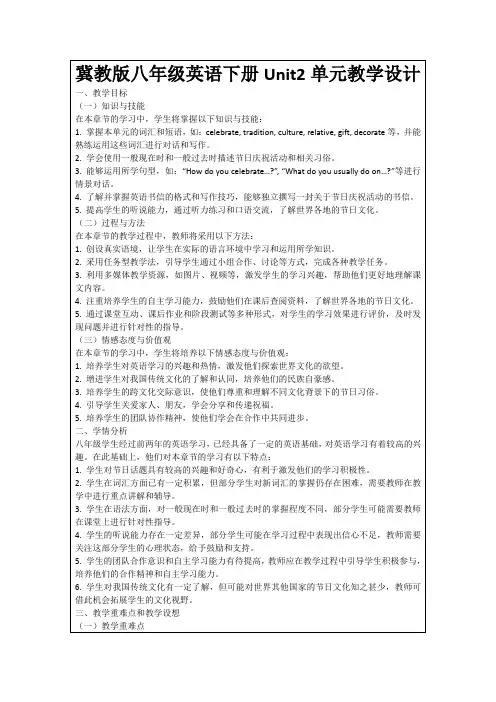
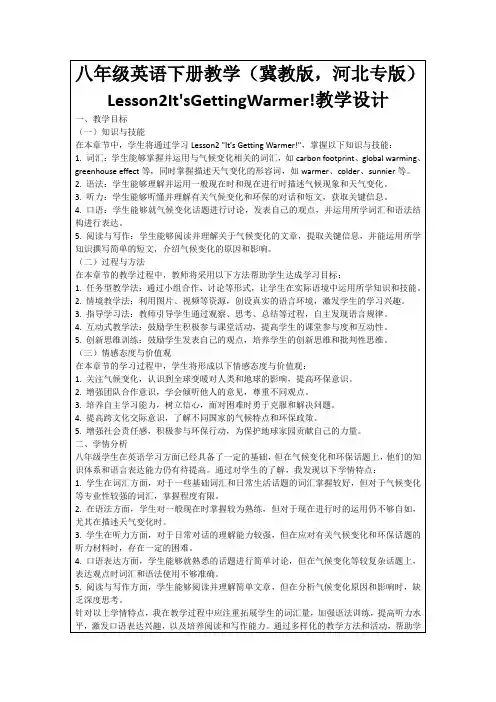

Lesson 8 Why Are Plants Important?【教学重点及难点】:1.重点:Master “Why are plants important?”能用本节所学短语准确表达植物在我们生活中的重要性。
2.难点:区分短语in trees与on trees【教学方法】:任务教学法,学生中心教学法,多媒体教学。
【教学工具】:多媒体,录音机Teaching Procedures:Step1: warming up1.learn new wordspleasant ['plez(ə)nt] adj. 使人愉快的shade [ʃeɪd] n. 树荫;阴凉处fulfill [ful'fil] v. 达到;执行basic['beɪsɪk] adj. 基本的;基础的soil[sɒɪl] n. 土;土壤T eacher will ask some students to read these new words and correct their pronunciation. And then ask them to tell the spelling according to the Chinese meaning to help them remember the words in the class.2. learn new phrases.help sb. with sth./ help sb. (to) do sth. it’s pleasant to do sth.in the shade under a tree fulfill one’s basic needstake energy from…. turn…into… in tress/ on treescarry…away in a word=in short be made of/from/in/by/up of…. Teacher will as k students to guess the Chinese meaning and lead them to read these phrases loudly.(设计意图:先给出音标,让学生通过音标认识单词,知道单词的读法,老师可以适当进行纠正他们的发音,对于读音有问题的音标进行突破,在教学当中渗透音标教学,帮助学生掌握音标发音规则,同时给出短语,让学生们在提前预习的基础上熟悉今天所要学习的短语,为下面自由讨论清扫障碍).Step2: TalkingTeacher will show some pictures about plants on the multimedia and ask students:“Why do we need trees? What kind of things can plants do? ”In the process, teacher can give students some phrases mentioned in the passage to help them to express themselves. such as :1. Plants make our world look beautiful.2. Trees help prevent the dust storm.3. Trees keep soil from being carried away, it can stop our land from becoming adesert.4. Trees and other plants help clean the air.5. Trees are the homes of animals, such as birds, squirrels, monkey, and so on.6. We can get nuts, fruits, clothing, paper from plants. Some trees can be used to make musical instruments. It can fulfill our basic needs.7. We can have a rest and play in the shade under a tree.8. Trees can help us solve the problem of global warming.(设计意图: 通过讨论引入话题,展现图片,每副图片都会展示植物的不同功能和作用,借助图片的启发和引导,把本课所要学习的重点句子和短语渗透到学生的答案当中去,通过小组比赛形式鼓励学生回答问题,积极思考,激发学生的表达兴趣,调动课堂气氛)Step 3: First ReadStudent should follow the audiotape to read the passage one sentence by one sentence. Teacher corrects the pronunciation during the period.(设计意图:纠正发音,学生通过跟读来揣摩句子的重读,弱读,失去爆破等现象,既掌握一些朗读技巧,提高听能水平,还促进对语言的整体感悟力,达到了听读的有机结合)Step4: Second ReadStudents read the passage a second time and finish let’s do it NO.1 Ask some students to answer questions and the teacher corrects the answers. And then teacher will lead students to read the nine sentences together.(设计意图:通过再次精读,使学生知道本文大意,能回答课后问题,加深对文章的理解,通过阅读积累素材,为以后的书面表达打下基础)Step5: Third ReadRead the dialogue again. Teacher will give the Chinese meaning and ask students to find out the expressions.帮助某人… help sb. with sth./ help sb. (to) do sth.做…很愉快it’s pleasant to do sth.在树荫底下 in the shade under a tree满足我们基本需求fulfill one’s basic needs从…获取能量take energy from….把….变成…turn…into…把…带走carry…away总之,简而言之 in a word=in short在树上 on trees(设计意图:帮助学生抓住本文重难点短语,突破学生对本文的理解障碍)Step 6: Studying language points1. It’s pleasant to do… 做….很愉快pleasant 指一般性的好,强调所修饰对象所具有的品质使人觉得好玩、有趣、舒服,含有客观性。
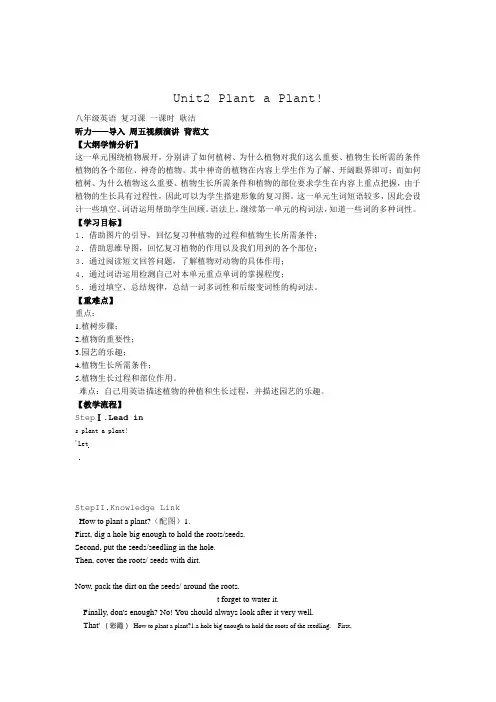
Unit2 Plant a Plant!八年级英语复习课一课时耿洁听力——导入周五视频演讲背范文【大纲学情分析】这一单元围绕植物展开,分别讲了如何植树、为什么植物对我们这么重要、植物生长所需的条件植物的各个部位、神奇的植物。
其中神奇的植物在内容上学生作为了解、开阔眼界即可;而如何植树、为什么植物这么重要、植物生长所需条件和植物的部位要求学生在内容上重点把握,由于植物的生长具有过程性,因此可以为学生搭建形象的复习图。
这一单元生词短语较多,因此会设计一些填空、词语运用帮助学生回顾。
语法上,继续第一单元的构词法,知道一些词的多种词性。
【学习目标】1.借助图片的引导,回忆复习种植物的过程和植物生长所需条件;2.借助思维导图,回忆复习植物的作用以及我们用到的各个部位;3.通过阅读短文回答问题,了解植物对动物的具体作用;4.通过词语运用检测自己对本单元重点单词的掌握程度;5.通过填空、总结规律,总结一词多词性和后缀变词性的构词法。
【重难点】重点:1.植树步骤;2.植物的重要性;3.园艺的乐趣;4.植物生长所需条件;5.植物生长过程和部位作用。
难点:自己用英语描述植物的种植和生长过程,并描述园艺的乐趣。
【教学流程】StepⅠ.Lead ins plant a plant!'LetStepII.Knowledge LinkHow to plant a plant?(配图)1.First, dig a hole big enough to hold the roots/seeds.Second, put the seeds/seedling in the hole.Then, cover the roots/ seeds with dirt.Now, pack the dirt on the seeds/ around the roots.t forget to water it.Finally, don's enough? No! You should always look after it very well.That'(彩霞)How to plant a plant?1.a hole big enough to hold the roots of the seedling. First, _______the roots of the seedling into the hole. Second,the hole with dirt. the roots and Thenthe dirt around the new tree with your feet. Next,Finally, _____ the seeding.What does it need to grow up?2.water, soil, sun, space, air, compost, much caresmall. very seedling became the seeds the come out of soil. And it a seedling. The is Later 3.It has two leaves. I take care of it and it keeps growing. Then we get a real plant.It has energy take soil. in they plant of the are roots.They at bottom the and are the They water and from the soil. Stem is thin and long upon the soil. It is like a road. All the energy and water go through it and arrive at the leaves or fruits. The leaves are on the stem or the branches. They take energy from the sun. They are very important. At the top of the plant, there is a bud. Later the bud will blossom and become a flower. After that, the flower will become a bud. That bud will turn into seeds. And we can continue to plant more plants.. Basic senseStepⅢListening1.Why do we need to plant plants? 2.Functions1)Parts of plants we eat. :Foodleaves:roots:fruits:seeds:stems:Clothing(cotton):The part of plants we use: fruitSchool things: stem,branches; seed,fruit/seed(rubber)Shelter: House: The part of plants we use : stemShade: The part of plants we use: leaves,branchesEnvironment: The part of plants we use: leaves, flowers, stem, branches, roots 2)Fun关键词:Enjoyable, pleasant, have fun doing2.Read the passage and answer the questions.Step IV.Overcome Difficulties1.Fill in the blanks.The first letter is given.1).2)Fill in the blanks with the correct forms of the given words.1.词汇与短语专练(晶晶)1). Look! They _____________ (dig) holes for the trees.Tom _______ already ______ (dig) many holes for the trees.2). ①The classroom is ___________ (足够大) to hold 50 students.②Don't worry! I can look after your child ___ when you areaway.A. careful enoughB. enough carefulC. carefully enoughD. enough carefully③The boy is so young that he can't look after himself.(同义句)The boy is ____ young ___ look after himself.The boy isn't ____ ________ to look after himself.3). ①Tom ______ the box _____ toys. It's too heavy to carry.A. full ; ofB. filled ; withC. was filled ; withD. was full ; of②The garden is _______ (长满) with flowers. How beautiful!③There are two bottles on the table. One is full ___ waterand the other is filled ____ milk.D. with ; ofC. of ; with B. with ; with A. of ; of4). My shirt is ______ (脏). I must wash it.5). Our city is in the __________ (north) part of China. It's verycold in winter.6). ①She covered her eyes ____ her hands.A. withB. forC. ofD. by②The ground is _________ (覆盖) with snow. How beautiful!7). It's ___________ (令人愉快的) to walk in the forest. It's niceand cool.8). We can have a rest in the ________ (树荫) under a tree whenthe weather is sunny and hot.9). Don't forget to put a little water in the _________ (底部) ofthe hole when you plant trees.10). Could you tell me what the_____ (基本的) steps for plantinga tree are ?11). _______, what's the best time to plant trees?A. On the wayB. In a wayC. By the wayD. In no way12). ①The book __ be Jim's because her name is on the cover.A. canB. mayC. mustD. need②--- Let's go to West Lake Park by taxi.--- It's not far. We ____ take a taxi.A. needn'tB. can'tC. mustn'tD. couldn't③--- I wonder if these are Danny's glasses.--- They _____ be Danny's. He doesn't wear glasses.A. can'tB. mustn'tC. needn'tD. wouldn't④--- Must I stay here with you?--- No, you ____. You may go home, but you ___ go to thenet bar.A. mustn't ; needn'tB. needn't ; mustn'tC. must ; needD. need ; must13). ①It's ______ (干燥的) and hot these days. We really needsome rain.②It hasn't rained since last month. The ground is very __.A. wetB. dryC. drierD. driestStep V.ExplorationQuestion: 1)What does the title “Plant a plant”mean? “Plant”can be both a noun and a verb.2)What does “dirt”mean? What does “dirty”mean? What's the relationship between them?s figure out the rule.'Let(宋佳)Plant a plant.The plants need water, so I water them.The orange is orange.I have a book that can help me book a hotel.Never trouble troubles until trouble troubles you.Can you can a can as a caner can a can?What can we do using this rule? We can understand the passage better. 1.Eg: This magazine whose cover is black is amazing.Choose some more sentences to let students guess the meanings. 2.We can stop any any bus stop.s very kind of you to give me all kinds of flowers.It'Opposite: like--_____ happy--_____ agree--_____ appear--____ understand--______V-n: drive--_____ visit--_____ lead--_____ move--_____ develop--_____ discuss--_____help--_____V--adj: care--____N--adj: rain-_____ sun-____ wind-_____Make a summary: -or/er,-hood,-ly,-ful, -ment, -tion, -shipDis-,un-, in-, mis-, ir-,多词性1)2)构词法(后缀)Step V. WritingWhat plant do you want to plant? How will you plant it? What does it need? What doyou want from it?What How Why(晶晶)同学们,你们种过树吗?请根据提示要求,以How to plant a tree为题写一篇英语短文,简单描述一下植树的过程。
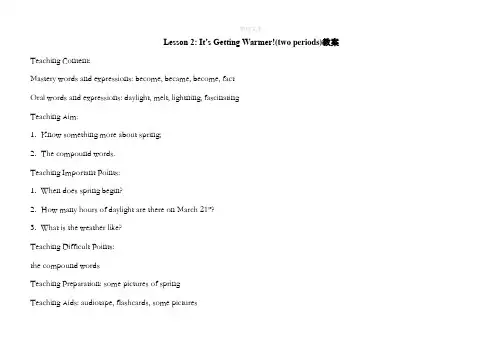
Lesson 2: It’s Getting Warmer!(two periods)教案Teaching Content:Mastery words and expressions: become, became, become, factOral words and expressions: daylight, melt, lightning, fascinatingTeaching Aim:1.Know something more about spring;2.The compound words.Teaching Important Points:1.When does spring begin?2.How many hours of daylight are there on March 21st?3.What is the weather like?Teaching Difficult Points:the compound wordsTeaching Preparation: some pictures of springTeaching Aids: audiotape, flashcards, some pictures.Type of lesson: new lessonTeaching Procedure:一、温故知新。
Check some words and phrases .二、激情导入。
Lead inLet the students on duty reports the weather to the class. The others listen and decide it is right or wrong.三、新课学习。
Step 1: Showing the teaching aims on the blackboard and asking students to read them together.1.Remembering some new words and phrases of lesson 2 work in group.2.Talking about seasons.3.Understanding the dialogue meaning.Step 2:Listen to the tape and answer the following questions:1.What’s the date today?2.How many ways can you write dates?3.How many hours of daylight are there on March 21st?4.What is spring weather like?.5.What is the temperature of the air near lighting?Step3. Read the text and check the answers.Step4. Listen to the tape again and imitate after it until they can read it fluently and correctly. Step5. Ask the students to ask other questions according to the text. You can begin like this:1.When does the sun rise in the morning and when does it set in the evening?2.Does it snow in early spring?3.What is sometimes with thunder and lighting?Step6. Come to “LET’S DO IT”.Work in groups and discuss these questions. Then let them report it to the class.四、达标训练,作业布置。
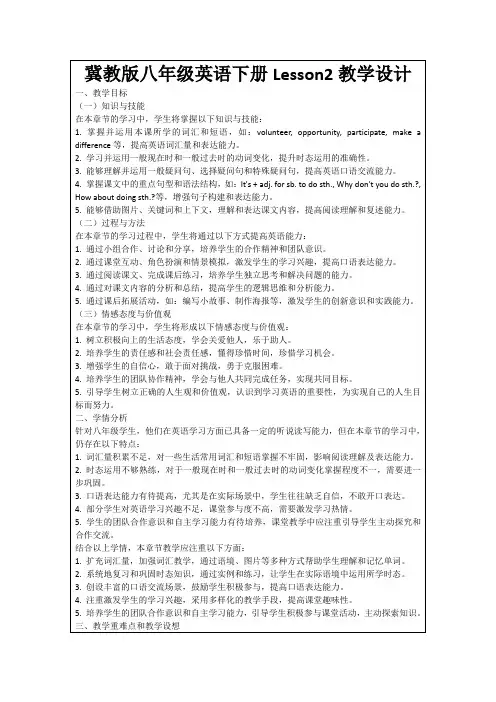
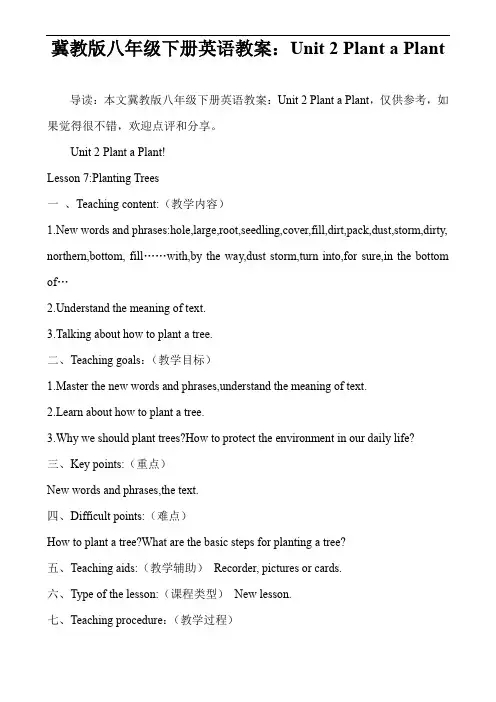
冀教版八年级下册英语教案:Unit 2 Plant a Plant导读:本文冀教版八年级下册英语教案:Unit 2 Plant a Plant,仅供参考,如果觉得很不错,欢迎点评和分享。
Unit 2 Plant a Plant!Lesson 7:Planting Trees一、Teaching content:(教学内容)1.New words and phrases:hole,large,root,seedling,cover,fill,dirt,pack,dust,storm,dirty, northern,bottom, fill……with,by the way,dust storm,turn into,for sure,in the bottom of…2.Understand the meaning of text.3.Talking about how to plant a tree.二、Teaching goals:(教学目标)1.Master the new words and phrases,understand the meaning of text.2.Learn about how to plant a tree.3.Why we should plant trees?How to protect the environment in our daily life?三、Key points:(重点)New words and phrases,the text.四、Difficult points:(难点)How to plant a tree?What are the basic steps for planting a tree?五、Teaching aids:(教学辅助)Recorder, pictures or cards.六、Type of the lesson:(课程类型)New lesson.七、Teaching procedure:(教学过程)Step 1.Analysis of the student.(学生分析)1.Greet the students in English and make sure they can response correctly.Do the duty report: a student on duty can say whatever he/she likes to say.2.Review:In last unit,we talked about the weather and spring,and we talked about some activities in spring,and we knew that,when we think of spring,we think of a season of fresh air,we think of new life,green plants all around us.3.Review the grammar:Word building.Step 2. Lead in.(引入)Homework check.Come to “Think About It”When is Tree planting Day in China?What are the basic steps for planting a tree?Step 3. New lesson.(新课)No. 1 prepare lessons before class.Teach the new words and phrases.make sure the Ss can read it correctly.No. 2Text:Give them some time to read the text themselves. Then let them act out the dialogue in groups. Correct their pronunciation when necessary.At last,the teacher explain the text in Chinese,make sure the Ss can understand the meaning of text.No. 3Important sentences:It's also a great way to learn about nature.It's fun and important to plant plants.No. 4Word building:north →northern dirt →dirtyNo. 5 Finish “Let's Do It!”Step 4. Play the tape for the Ss to follow.Make the Ss listen the text,then let them read follow the tape.Step 5.Summary. (小结)Sum up the text what we learned,the new words,phrases,and sentences. Sum up the grammar.Step 6. Homework.(作业)Finish the activity book and the practice.Copy the new words and phrases twice.Step 7.Blackboard-writing:(板书)The new words,the master phrases,important sentences.The grammar and practice.八。
【冀教版】2019年春八年级英语下册Unit2单元教学案集Unit2Plant a PlantLesson7Planting treesThis unit is mainly tellin us how to plant trees.The students like this topic.It is about the spring activities,especially tree planting.【知识与能力目标】(1)学会句型Did you do sth yesterday?并能用该句型结合情景做对话。
(2)学习一般过去时的用法。
【过程与方法目标】通过网上查找资料,听课文录音和请教高年级学生等方式,初步掌握掌握课文背景和句型。
通过小组合作学习进一步提高单词的拼读能力。
通过全班展示和教师点拨熟练掌握课文知识并能在实际中运用。
【情感态度价值观目标】培养学生敢于用英语讨论过去的时间所做的事情,加深学习英语的兴趣。
【教学重点】学习句型Did you do sth yesterday?并能用该句型进行交际。
【教学难点】熟练运用句式Did you do sth yesterday?进行交际。
过去式的读音。
图片,PPTStep1.Analysis of the student.1.Greet the students in English and make sure they can response correctly.Do the duty report:a student on duty can say whatever he/she likes to say.2.Review:In last unit,we talked about the weather and spring,and we talked about some activities in spring,and we knew that,when we think of spring,we think of a season of fresh air,we think of new life,green plants all around us.3.Review the grammar:Word building.Step2.Lead in.(引入)Homework check.Come to“Think About It”When is Tree planting Day in China?What are the basic steps for planting a tree?Step3.New lesson.(新课)No.1Prepare lessons before class.Teach the new words and phrases.Make sure the students can read it correctly.No.2Text:Give them some time to read the text themselves.Then let them act out the dialogue in groups.Correct their pronunciation when necessary.At last,the teacher explains the text in Chinese.Make sure the students can understand the meaning of text.No.3Important sentences:It’s also a great way to learn about nature.It’s fun and important to plant plants.No.4Word building:north→northern dirt→dirtyNo.5Finish“Let’s Do It!”Step4.Play the tape for the students to follow.Make the students listen the text,and then let them read follow the tape.Step5.Summary.(小结)Sum up the text what we learned,the new words,phrases,and sentences.Sum up the grammar.Step6.Homework.(作业)Finish the activity book and the practice.Copy the new words and phrases twice.Unit2Plant a PlantLesson8Why are plants important?本单元围绕“植树”这个话题,学习和了解植树的重要性及如何栽树。
英语初二下冀教版unit2单元教案Step1:复习巩固、激情导入复习:提问Unit1重点短语、句型导入:Haveyoueverplantedaseed?Howdoyouplantaseed?Step2:出示目标、明确任务1.牢记本课黑体词汇:plant/grow/water/leaf/lend/ruler/discuss/cover/itself/root等;2.熟读对话,把握其意;3.背诵重点句子1-4,并灵活运用相关知识点。
Step3:自主学习、合作探究任务一:限时5分钟,熟读所有词汇,牢记黑体词汇任务二:熟读对话,把握其意,画出不理解处,同桌之间交流任务三:背诵重点句子,并自学知识点,画出不理解处,同桌之间交流1.Wouldyoulikesomemarkers?2.Wouldyoupleaselendmeyourgreenmarker?3.Roots“growinto”plants?4.Don’tforgettodrawthesun.Step4:师生互动、展示提升互动一:单词经历竞赛互动二:对话熟读接力赛互动三:知识点展示大比拼✩知识点一:Wouldyoulikesomemarkers?wouldlike意为“盼望、想要”,在意思上相当于want,但语气要比want委婉。
【固定短语】wouldlikesth=wantsthWouldliketodosth=wanttodosthWouldlikesbtodosth=wantsbtodosth【固定句型】1:Wouldyoulikesth?对Wouldyoulikesth?提出的建议或要求作答时,依照自己的实际需要回答:确信回答用Yes,please.否定回答用No,thanks./No,thankyou.Eg:---Wouldyoulikesomemoresoup?---No,thanks.It’sdelicious,butI’vehadenough.2.Wouldyouliketodosth?Wouldyouliketodosth?用于要求对方做某事,常译为“请你做……好吗?”其回答方式有多种。
冀教版八年级下册英语教案:Unit 2 Plant a Plant 教案是教师为顺利而有效地开展教学活动,根据课程标准,教学大纲和教科书要求及学生的实际情况,以课时或课题为单位,对教学内容、教学步骤、教学方法等进行的具体设计和安排的一种实用性教学文书,包括教材简析和学生分析、教学目的、重难点、教学准备、教学过程及练习设计等,下面是由小编为大家整理的范文模板,仅供参考,欢迎大家阅读.Unit 2 Plant a Plant!Lesson 7:Planting Trees一、Teaching content:(教学内容)1.New words and phrases:hole,large,root,seedling,cover,fill,dirt,pack,dust,storm,dirt y,northern,bottom, fill……with,by the way,dust storm,turn into,for sure,in the bottom of…2.Understand the meaning of te_t.3.Talking about how to plant a tree.二、Teaching goals:(教学目标)1.Master the new words and phrases,understand the meaning of te_t.2.Learn about how to plant a tree.3.Why we should plant trees?How to protect the environment in our daily life?三、Key points:(重点)New words and phrases,the te_t.四、Difficult points:(难点)How to plant a tree?What are the basic steps for planting a tree?五、Teaching aids:(教学辅助) Recorder, pictures or cards.六、Type of the lesson:(课程类型) New lesson.七、Teaching procedure:(教学过程)Step 1.Analysis of the student.(学生分析)1.Greet the students in English and make sure they can response correctly.Do the duty report: a student on duty can say whatever he/she likes to say.2.Review:In last unit,we talked about the weather and spring,and we talked about some activities in spring,and we knew that,when we think of spring,we think of a season of fresh air,we think of new life,green plants all around us.3.Review the grammar:Word building.Step 2. Lead in.(引入)Homework check.Come to “Think About It”When is Tree planting Day in China?What are the basic steps for planting a tree?Step 3. New lesson.(新课)No. 1 prepare lessons before class.Teach the new words and phrases.make sure the Ss can read it correctly. No. 2Te_t:Give them some time to read the te_t themselves. Then let them act out the dialogue in groups. Correct their pronunciation when necessary.At last,the teacher e_plain the te_t in Chinese,make sure the Ss can understand the meaning of te_t.No. 3Important sentences:It’s also a great way to learn about nature.It’s fun and important to plant plants.No. 4Word building:north →northern dirt →dirtyNo. 5 Finis h “Let’s Do It!”Step 4. Play the tape for the Ss to follow.Make the Ss listen the te_t,then let them read follow the tape.Step 5.Summary. (小结)Sum up the te_t what we learned,the new words,phrases,and sentences. Sum up the grammar.Step 6. Homework.(作业)Finish the activity book and the practice.Copy the new words and phrases twice.Step 7.Blackboard-writing:(板书)The new words,the master phrases,important sentences.The grammar and practice.八。
第二课时Lesson 8Why Are Plants Important?课时目标
一、根据句意及首字母或汉语提示写出单词。
1.She provides a pleasant and comfortable office for us.
2.The trees provide shade for the animals in the summer.
3.We must fulfill (完成) the task,whatever happens.
4.The government tries to satisfy their basic (基本的) needs.
二、写出下列画线短语的汉语意思。
1.There are so_many trees and plants.如此之多
2.They help us fulfill our basic_needs.基本需求
3.Look,there is an apple tree over_there! 在那边
4.That way,the wind and water don't carry the soil away.带走
教学过程
环节1新课导入
教师请三名学生起来表演上一课时的对话,然后教师在PPT上呈现上一课时的重点单词和短语,点名请学生来回答它们的意思,并用这些单词和短语造句。
设计意图:通过表演对话和复习单词、短语,帮助学生巩固所学内容;同时检查学生对上节课的掌握情况,为新课做准备。
环节2新课学习
1.教师让学生阅读Lesson 8中“THINK ABOUT IT”里的两个问题,然后思考在自己的家附近有些什么树,以及我们为什么需要这些树。
思考完后可以和同桌讨论这两个问题。
2.教师请两名学生谈谈自己的想法。
3.教师给学生两分钟时间,阅读本课时的对话,把握对话大致意思。
教师播放录音,学生注意录音的语音语调和句子的停顿并小声跟读。
4.教师让学生再次阅读对话,勾画出其中的生词、重要短语以及句子,然后教师进行讲解。
5.学生三人一组进行对话练习。
学生先熟读对话,然后和其余两名搭档一起表演这个对话。
6.学生浏览活动1的题目和下方的内容,勾出文中提到的信息,然后教师核对答案。
7.教师让学生浏览活动2方框中的单词以及下方的短文,然后把短文内容补充完整,教师请几名学生起来回答,同时订正答案。
8.学生四人一组进行活动。
学生讨论树木的功能,并把活动3的信息补充完整。
9.教师请几名学生分享他们的答案,然后归纳人类需要树木的原因以及树木在人类生活中起到的作用。
10.要点点拨。
There are so many trees and plants.
so ad v.如此;这么。
它主要有以下三种用法:
①“so+many/much/few/little+名词”表示“如此多/少的……”,其中,many/few修饰可数名词复数,much/little修饰不可数名词。
例:It's hard to believe that he ate so much food today.
他今天吃了那么多东西,简直让人难以置信。
②“so+形容词/副词+that从句”表示“如此……以至于……”例:The waterfall was so amazing that many tourists stopped to take photos.这帘瀑布是如此的让人惊异,以至于许多游客停下来拍照。
③so+形容词+a/an+可数名词单数。
它可与“such+a/an+形容词+可数名词单数”进行句型转换。
例:She is so beautiful a girl.=She is such a beautiful girl.她是一个如此美丽的女孩。
11.学以致用。
(根据汉语意思完成句子,一空一词)
(1)对于我们来说,当我们遇到麻烦时,很有必要跟父母讲一讲。
It's necessary for us to talk to our parents when we have problems.
(2)这天气是如此的炎热,以至于街上很少有人。
The weather is so hot that there are few people in the street.
(3)商店里有那么多特别的礼物,你可以看一看。
There are so many special presents in the shop.You can have a look there.
(4)总之,我们相信你刚才说的话。
In a word,we believe what you said just now.
设计意图:通过思考课本中提出的问题,增强学生乐于思考的意识;通过练习,让学生更进一步地感受单词和短语的用法。
板书设计
练习设计
请完成本课对应训练!。